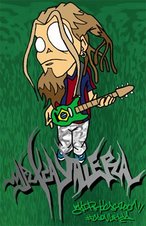
Stratospheric traces of our transitory flight
Trails of condensation held
In narrow paths of white
The sun is turning black
The world is turning gray
All the stars fade from the night
The oceans drain away
Horizon to horizon
Memory written on the wind
Fading away like an hourglass, grain by grain
Swept away like voices in a hurricane
In a vapor trail
Atmospheric phases make the transitory last
Vaporize the memories that freeze the fading past
Silence all the song birds
Stilled by the killing frost
Forests burn to ashes
Everything is lost
Washed away like footprints in the rain
In a vapor trail Obscured lyrics that can be interpreted as dealing with atmospheric pollution. Vapor trails are condensed water vapors upon particles emitted from the exhaust of airplane engines, when certain atmospheric conditions allows such a phenomenon. These fuel emissions, invisible in other way, destroy ozone layer and enhance global warming, especially today when air transportations are steadily increased. There are also many studies that support an impact of vapor trails themselves to climatic change, acting as back-to-Earth reflecting surfaces of thermal radiation as we read in wikipedia:
Obscured lyrics that can be interpreted as dealing with atmospheric pollution. Vapor trails are condensed water vapors upon particles emitted from the exhaust of airplane engines, when certain atmospheric conditions allows such a phenomenon. These fuel emissions, invisible in other way, destroy ozone layer and enhance global warming, especially today when air transportations are steadily increased. There are also many studies that support an impact of vapor trails themselves to climatic change, acting as back-to-Earth reflecting surfaces of thermal radiation as we read in wikipedia:
Vapor trails or contrails, by affecting the Earth's radiation balance, act as a radiative forcing. Studies have found that vapour trails or contrails trap outgoing longwave radiation emitted by the Earth and atmosphere (positive radiative forcing) at a greater rate than they reflect incoming solar radiation (negative radiative forcing). Therefore, the overall net effect of contrails is positive, i.e. a warming. However, the effect varies daily and annually, and overall the magnitude of the forcing is not well known: globally (for 1992 air traffic conditions), values range from 3.5 mW/m² to 17 mW/m². Other studies have determined that night flights are most responsible for the warming effect: while accounting for only 25% of daily air traffic, they contribute 60 to 80% of contrail radiative forcing. Similarly, winter flights account for only 22% of annual air traffic, but contribute half of the annual mean radiative forcing.
The grounding of planes for three days in the United States after September 11, 2001 provided a rare opportunity for scientists to study the effects of contrails on climate forcing. Measurements showed that without contrails, the local diurnal temperature range (difference of day and night temperatures) was about 1 degree Celsius higher than immediately before; however, it has also been suggested that this was due to unusually clear weather during the period.
There is also a conspiracy theory that certain types of vapor trails are toxic chemicals spread in the atmosphere for some secret unindentified evil purposes, the so called chemtrails. In some cases they are some chemical agents for weather control, but the majority of all these theories seem to be implausible.
You can hear this song in youtube



4 comments:
Hello there. This song, as well as most of the rest of the album, were written in the aftermath of drummer Neil Peart's personal tragedies (he lost first his daughter, then his wife within 10 months of each other). From that perspective, you can see that it's a song of grief, how the world seems to end when you lose someone, and the bitterness you feel at the fleetingness and possible futility of life and human endeavor.
Then again yours is a valid secondary interpretation as Peart certainly has concerns about the environment.
Including The Trees as your other Rush entry is interesting. I don't consider that song to be environmental at all. It's sociopolitical allegory.
When I saw you were listing 2 Rush songs on this site, I figured they'd be Second Nature (off Hold Your Fire) and Red Tide (off Presto), the 2 direct, intentional eco songs! (hint, hint!)
Thank you very much for your interesting information. We also check and post the songs you propose!
The guy is definitely just, and there's no doubt.
I absolutely tie in with anything you've presented us.
Post a Comment